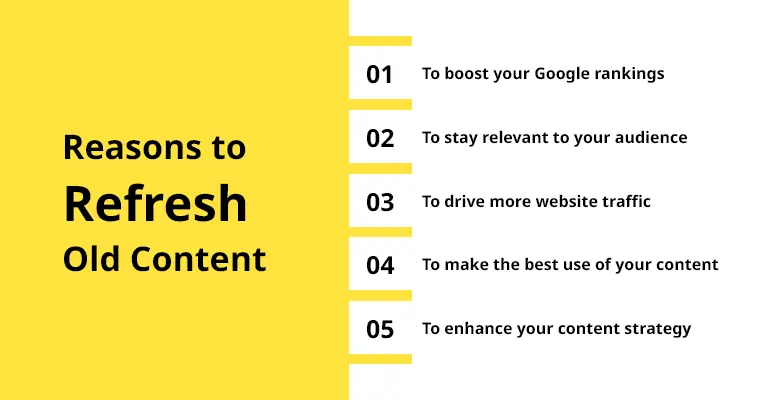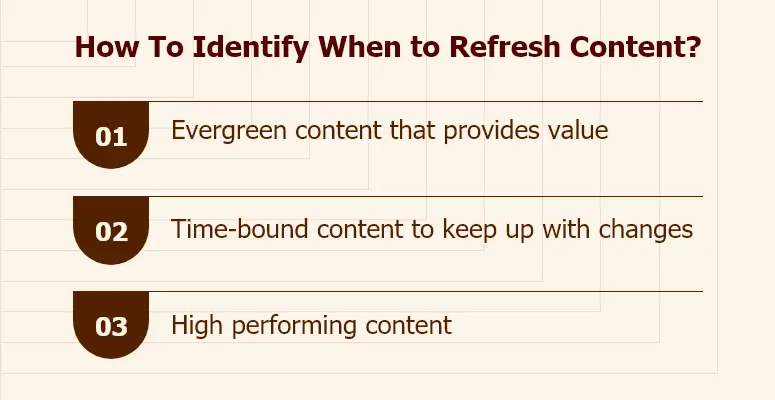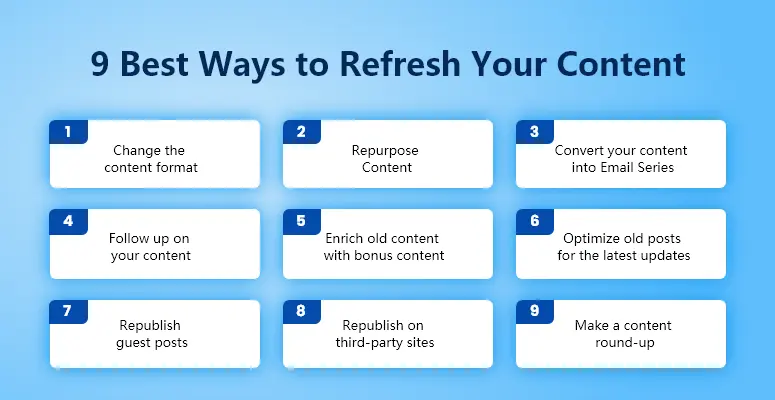Creating New content constantly is the new way for bringing in traffic to your website. But over time some of your content might get old and traffic to those old content might decline.
In this post, we will learn how to refresh old content for SEO & bring in those numbers back.
Why Should You Refresh Old Blog Content for SEO?
There are several ways you can bring back life to your old content, the reason why you should refresh them are:
- Boost Your Google Rankings: Keep Your Content Fresh – Google prioritizes relevant content, and outdated material doesn’t fit the bill. Regularly updating your content increases the likelihood of your SEO efforts paying off.
- Stay Relevant to Your Audience: Keep Your Content Up-to-date – In an ever-changing digital landscape, it’s essential to continuously update your content to align with your audience’s needs and interests.
- Drive More Traffic to Your Site: Revitalize Underperforming Content – Revamping old content can involve SEO updates, which can lead to increased traffic from previously overlooked pieces.
- Squeeze More Out of Your Content: Give Your Old Content a Second Life – Reviving old content can help you realize its full potential by providing new value to your audience.
- Efficient Content Creation: Leverage Old Content Instead of Starting From Scratch – Updating and repurposing existing content takes less time and effort than creating new material from scratch.
How To Identify When to Refresh Content for SEO?
Not all of your old content can be repurposed. A content audit will help you identify which pieces are worth updating and which ones should be discarded. Look for the following types of content:
- Evergreen Content: Timeless Pieces That Provide Value – Some types of content will always be relevant and beneficial to readers. Examples include how-to guides, resource lists, FAQs, checklists, and best practices. For instance, “Kitchen Hacks” from Mercato, is a good example of evergreen content.
- Time-Bound Content: Keeping Up with Changes – Some types of content are only relevant for a specific period of time, such as statistics, research, software updates, new regulations, industry reports, and trends. These pieces need to be updated regularly to stay current. Examples include updating statistics, research, and trends in your industry.
- Revitalizing High-Performing Content: Building on Success – Successful content that generated a lot of engagement can be updated and republished to attract new readers and continue to provide valuable information.
How to Update Old Blog Posts?
9 Effective Ways.
1. Change the content format
One way to refresh old blog content for SEO and attract new traffic is by creating a video based on a successful blog post. Additionally, there are several other creative ways to update old content for your audience.
Some examples include turning an ebook into a blog post series, writing a blog post on a podcast episode, creating an infographic from a blog post, transforming content into slideshows for SlideShare, consolidating related blog posts into one, and expanding a popular blog post into a mini-course.
2. Repurpose Content
Content Repurposing on social media can be a great way to increase visibility and drive traffic to your website. By breaking your content down into smaller pieces, such as bullet points, quotes, statistics, summaries, and visuals, you can easily share it on platforms like Instagram and Twitter.
This not only saves time on creating new content but also promotes your older content by bringing new attention and engagement to it.
You can for example share key points from your post as tweets, and post images with captions highlighting key paragraphs on Instagram.
3. Convert your content into Email Series
As your email list grows, you may have new subscribers who have not yet seen your previous content. One way to introduce them to your older, but still valuable, content is by breaking it down and refining it for your email subscribers.
This can make it more accessible and easy to understand for new readers. Additionally, repurposing your old content in this way can provide new ideas for email content and drive traffic back to your older blog posts.
4. Follow up your content
Instead of starting from scratch, consider revisiting a blog post that performed well in the past. There is often more to say on a topic and new updates that can be highlighted, which can attract both new and returning readers.
By updating and expanding on the original post, and linking back to it, you can provide more value to your audience.
5. Enrich old content with bonus content
When updating old content, take the opportunity to promote your latest products or generate new leads by creating a lead magnet. Remove outdated calls-to-action (CTA) and provide something current and useful for your audience.
Some options for lead magnets include infographics, a PDF version of the blog post, industry reports, webinars, ebooks, templates, and checklists. Make sure the offer is well-designed and visually appealing, as people appreciate the added value to the content.
6. Optimize old posts for the latest updates
To refresh old blog content for SEO and make it relevant, there are certain elements to consider. One is to improve the meta descriptions, by comparing them to those of high-ranking competitors on SERPs and highlighting the reader’s pain points to establish a connection.
Another is to remove outdated links, examples, statistics, and tips, as well as update the date of the blog post to give it a new and current appearance. Additionally, targeting newer keywords can help the old content rank for currently trending terms.
Use Google Search Console, by going to Search Traffic, then select Search Analytics under the Search Traffic section.
From there, select Pages, and check Clicks, Impressions, CTR, and Position, which will show all the pages on your site and their rankings.
It is recommended to focus on pages that are in the position range of 1-30, as they have the potential to perform well if optimized.
Additionally, it is important to research fresh keywords to keep old content relevant and updated, in order to attract higher rankings.
You can use Google Search Console, by staying on the same page and switching the category from “Pages” to “Queries.” Filter the results by impressions, and select the query with the highest number of impressions as your focus keyword.
Then, develop long-tail keywords using Google autocomplete suggestions, related searches, the People also ask section and Google Trends.
7. Republish Guest Posts
As a site owner, if you have done guest blogging in the past, you can republish that content on your own blog. To do this, you can simply ask the site owners if it’s okay to republish the content, which is often allowed since it has already been published on their site for a while.
Make sure to link back to the original site where it was first published. This can be an effective way to refresh the content on your blog, while also promoting your offers with a call-to-action (CTA) at the end of the post.
8. Republish on third-party sites
Republishing your content on third-party sites is a great way to attract traffic from their large audiences to your blog.
Some popular platforms to consider include Medium, a self-publishing platform with over 180 million monthly visitors, LinkedIn, a professional networking and blogging platform, Reddit, a site where external links drive the most engagement, and Quora, a Q&A platform.
By republishing your old content on these sites, you can boost your online presence and bring your content to new audiences.
9. Make a content round-up
Repurposing old content involves creating a new article or post that highlights previous content on a related topic.
This can include both older and more recent pieces. It’s important to ensure that the old content is still relevant and has been optimized for your audience before repurposing it.
Here are some examples:
- “Our best posts on xxx of all time”
- “Top 5 articles we published on xxx”
- “Compilation of our most popular blog posts in 2022”
- “Throwback yet still relevant blog posts we published on xxx”
- “[Insert blog name] most valuable posts ever”
Wrap Up
Old content can bring new value to your blog by highlighting previous articles and bringing them back into the spotlight. It can also be a break from constantly coming up with new ideas, and instead, building on what you have already published.
By refreshing your old content, you can not only give those older articles new life but also gain insights into what has performed well in the past to create even better content in the future. Therefore, it is important to balance creating new content and repurposing old content to keep your audience engaged.
So, consider revisiting your older content and making updates to ensure it is still relevant and to gain more recognition from your audience.
Published by
Divanshu
Divanshu is an engineer turned marketer. As SEO Manager, he is responsible for implementing strategies that help Scrapingdog to increase brand awareness, generate leads and acquire new customers. When he isn't working you'll find Divanshu reading, watching thriller shows, or playing online games.
All stories by Divanshu







Pingback: How Keyword tracking helps for your Content Strategy in SEO